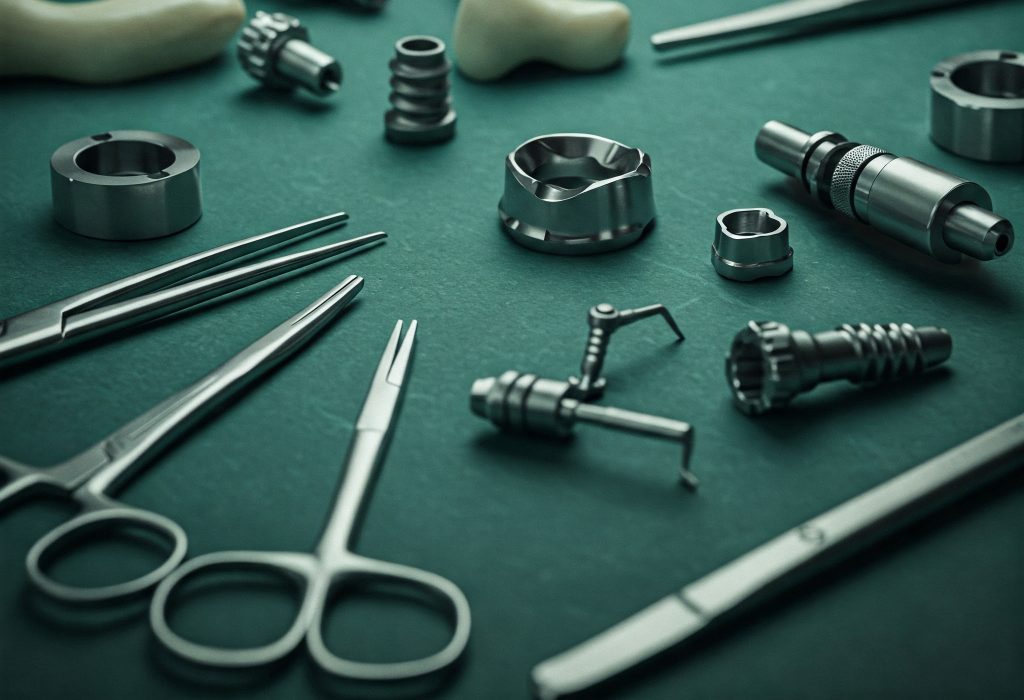The biomedical industry increasingly demands high-precision metal components, complex geometries, and biocompatible materials, along with manufacturing processes capable of ensuring quality, repeatability, and large-scale efficiency. In this context, Metal Injection Molding (MIM) technology has established itself as a strategic solution for the production of small, highly complex metal parts, offering an optimal balance between design freedom, functional performance and economic viability. Let’s explore how MIM technology is applied in the biomedical industry, addressing its key advantages, areas of application, employed materials, and development prospects.
Key Advantages of the MIM Process for Biomedical Applications
The adoption of MIM technology in the biomedical field is driven by a combination of technical and production factors that meet the industry’s stringent requirements:
- High design freedom: Although MIM has some limitations compared to other Additive Manufacturing technologies, it allows the production of parts with complex geometries, internal channels, hard-to-reach areas, and precise details
- Reproducibility and dimensional control: The MIM process ensures tight tolerances and stability in large-scale production.
- Exceptional mechanical properties: MIM parts achieve densities between 97% and 99%, depending on the material, with superior mechanical strength and no critical porosity.
- Compatibility with biocompatible materials: Including surgical stainless steels, titanium alloys, cobalt-chrome, and other noble metals.
- Cost and lead time reduction: Especially when compared to machining or investment casting for complex and high-volume components.
Application Areas in the Biomedical Industry
 Today, MIM technology is present in many areas of the medical and healthcare industry. Its main applications include:
Today, MIM technology is present in many areas of the medical and healthcare industry. Its main applications include:
- Surgical Instruments
The manufacturing of components for surgical instruments is one of the most established fields for MIM, particularly in:
• Forceps, scissors, and clamps for minimally invasive surgery.
• Surgical staplers and suturing systems.
• Components for robotic surgery and precision tools. - Endoscopic and Laparoscopic Devices
The miniaturization and precision required in endoscopic devices have driven the use of MIM in the production of:
• Biopsy forceps and graspers.
• Moving elements for endoscopic navigation systems.
• Microstructural components with strict geometric requirements. - Diagnostic and Drug Delivery Equipment
MIM plays a key role in manufacturing components for:
• Drug delivery systems.
• Internal components of infusion pumps.
• Structural and functional parts for imaging and chromatography diagnostic equipment. - Prosthetics and Implants
Although MIM has some limitations in terms of customization, it has become well-established in producing:
• Parts for orthopedic prosthetics (hip, knee, spine).
• Dental and orthodontic implants.
• Metal elements for bone fixation systems.
Its application in this field requires the exclusive use of certified implantable materials, as well as strict quality controls and regulatory validation.
Materials Used
The evolution of MIM technology has enabled the incorporation of a wide range of metal materials that meet the requirements of the medical industry. The most relevant are:
| Material | Typical Application |
|---|---|
| Stainless Steel 316L | Surgical instruments, dental implants |
| Stainless Steel 17-4 PH | High-strength surgical instruments |
| Ti-6Al-4V | Prosthetics, orthopedic and dental implants |
| Cobalt-Chrome | Joint prosthetics, medical implants |
| MP35N | Implantable devices, fatigue-resistant components |
| Inconel 625 | Medical equipment for demanding environments |
| Tantalum (Ta) | Dental and cranial implants |
| Tungsten (W) | Medical shielding, radiation protection |
The development of new metal powders, along with advances in binder formulations and debinding and sintering processes, has expanded the range of certified materials for medical applications.
Current status and MIM trends in the biomedical industry
The application of MIM technology in the biomedical industry is expanding rapidly, driven by:
- The growing demand for miniaturized medical devices.
- The need for large-scale production of precision components
- Continuous improvement in MIM process quality and repeatability.
- The incorporation of new biocompatible materials and advanced alloys.
Additionally, the integration of digital technologies (molding simulation, intelligent process control) and the optimization of multi-cavity systems enhance productivity and reduce costs. Emerging trends include:
- Micro-MIM for microcomponents, enabling the production of parts smaller than 1 mm.
- Development of composite materials and specific alloys for implantable devices.
- Combining MIM with Additive Manufacturing for customized parts.
- Application of post-MIM functional coatings to enhance biocompatibility and wear resistance
Conclusions
MIM technology has established itself as a reference solution for manufacturing metal components in the biomedical industry, thanks to its ability to combine precision, efficiency, and compliance with the industry’s strict regulatory requirements. .
The current state of MIM technology ensures reliable production of surgical instruments, endoscopic devices, and diagnostic equipment, while progressively advancing into specific types of medical implants. Ongoing advancements in materials, processes, and quality control suggest a sustained growth in the application of MIM technology in the biomedical field in the coming years.


